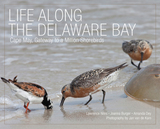
Every corner of New Jersey harbors natural wildlife of such value that it attracts birders and other naturalists from around the world. From the barrier beaches and coastal marshes at the ocean’s edge, through the flood plain forests and pine barrens, across the fertile rolling hills of the piedmont, to the highlands, ridges, and valleys of northwestern New Jersey, the state is a cornucopia of wildlife. With over 500 species calling the state home, New Jersey ranks as one of the most diverse wildlife habitats in the country. The state’s importance doesn’t end at the borders¾ New Jersey provides critical food and shelter to hundreds of species that use the state as a stop along their migratory route. Yet, in the nation’s most densely populated state, the loss of habitat continues at a relentless pace. The race is on to save natural areas and the species dependent upon them for survival.
Endangered and Threatened Wildlife of New Jersey is a richly illustrated color guide to the state’s fifty-four most imperiled species, from bobcats to bobolinks, shortnosed sturgeons to loggerhead turtles, frosted elfins to triangle floaters, blue whales to American burying beetles. Here, the authors detail each animal’s natural history, reasons for its decline, what’s been done so far¾and what must be done¾to keep New Jersey’s wildlife flourishing.
Written primarily by the people who know these species best, the biologists of the New Jersey’s Endangered and Nongame Species program, the book is divided into seven sections¾ mammals, birds, reptiles, amphibians, fish, insects, and bivalves. A chapter on individual species details animal identification, distribution, habitat, diet, life cycle, status and conservation, and limiting factors and threats, as well as recommendations for preservation. The authors also explore the particular characteristics of the species within New Jersey, including the species’ distribution, population status, and breeding and migration behaviors. Sixty-three detailed maps and more than one hundred spectacular color photos provide readers with a rare glimpse of these seldom-seen species.
Wildlife serves as a harbinger for our own environment: If the air, water, and earth aren’t healthy for animals, they surely can’t be healthy for humans. Endangered and Threatened Wildlife of New Jersey¾ an extraordinary resource and educational tool for anyone interested in preserving the state’s natural heritage¾provides a valuable wake-up call for us all.

The Delaware Bay is the second largest and most diverse bay on the East Coast. It has a rich cultural history, has played an important role in the region’s commerce and tourism, and has spectacular and vital natural resources. Birdwatchers gather along its shores to watch the spectacle of thousands of spawning horseshoe crabs, the dense flocks of migrant shorebirds, the fall hawk migration, and the huge migration of monarch butterflies.
Life Along the Delaware Bay focuses on the area as an ecosystem, the horseshoe crab as a keystone species within that system, and the crucial role that the bay plays in the migratory ecology of shorebirds. An abundance of horseshoe crabs spawning on the Delaware Bay beaches results in an abundance of eggs brought to the surface, providing a source of high-quality food and bringing hundreds of thousands of shorebirds to the bay to forage in late May and early June. A dramatic decline in horseshoe crabs has resulted in a rapid and dramatic decline in birds, particularly the red knot. This decline has sounded an alarm throughout the world, prompting a host of biologists to converge on the bay each spring, to understand the biology and conservation of red knots and other shorebirds.
Lawrence Niles, Joanna Burger, and Amanda Dey examine current efforts to protect the bay and identify new efforts that must take place to ensure it remains an intact ecological system. Over three hundred stunning color photographs and maps capture the beauty and majesty of this unique treasure—one that must be protected today and for generations to come.
READERS
Browse our collection.
PUBLISHERS
See BiblioVault's publisher services.
STUDENT SERVICES
Files for college accessibility offices.
UChicago Accessibility Resources
home | accessibility | search | about | contact us
BiblioVault ® 2001 - 2024
The University of Chicago Press









